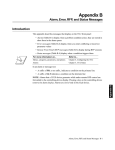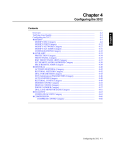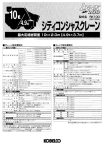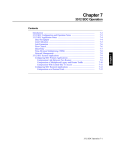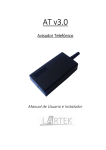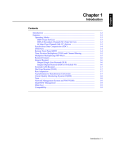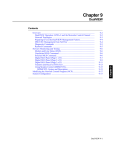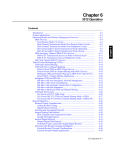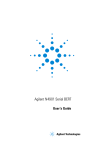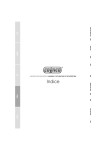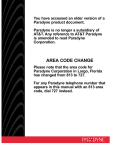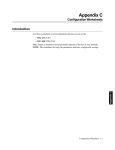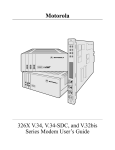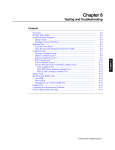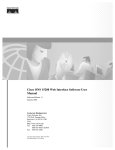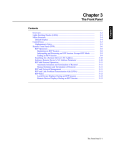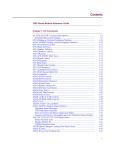Download Tran:3512 DSU/CSU User`s Manual:Index
Transcript
Index Symbols "," as dial modifier 4-56 "<" as dial modifier> 4-56 "K" as dial modifier 4-56 "K" or "k" as dial modifier 4-57 "P" as dial modifier 4-53 "P" or "p" as dial modifier 4-57 "T" as dial modifier 4-53 "T" or "t" as dial modifier 4-57 "W" or "w" as dial modifier 4-57 *AUXILIARY main manu 4-33 *COMPRESSION main menu (SDC) 4-66 *DUALVIEW main menu 4-63 *MODIFY main menu 4-7 *RESTORAL main menu 4-40 *STATUS main menu 5-2 *TEST main menu 8-3 Numerics 141 (Circuit 141) parameter 4-26 326X interoperation 1-9 326X SDC restoral interoperation (SDC) 4-69 3500 and 3512 under network management 4-30 3512 connection to telephone line 2-6 environmental limits 10-2 features 1-3 operating mode 1-3 rates and services 10-3 size, weight, heat output 10-2 3520 installation requirements 2-4 interoperability 6-15 3520 interoperability and port-to-channel mapping 6-17 64 kbps Clear Channel (64k CC) service 1-3 64CC alarm B-2 64k CC and accidental loopbacks 4-8 and non-interruptive network management 613 configuring bitstealing 4-19 configuring multiplexing 4-19 latching loopbacks (LLBs) 4-15 loopback test 8-13 Opmode parameter 4-8 64k CC Latching Loopback alarm 5-6 64k CC LTCH LB message B-2 64k LDM tail circuit 6-46 64LL alarm 5-6 6500 Series devices 7-9 68HC000 microprocessor 1-3 A A/B Only parameter 4-51 A/B restoral 4-40 feature 1-7 A/B restoral (See External restoral) A/B switch and SDC 7-11 ABN STATION x message B-2 ACROSS key 3-5 ACTIVATE RESTORAL category 4-42 Adaptor cables for DTEs 2-9 Address, Motorola Codex Customer Administration 2-3 ALARM STATUS category 5-5 Alarms Abnormal Station 4-46 DDS 4-46 history 5-5 No Sealing Current 4-46 Out of Frame 4-46 Out of Service 4-46 that initiate restoral 4-46 Alphanumeric entry 3-5 ALT message-suffix B-1 Analog restoral 4-52 Ans (Answer) Timeout parameter 4-56 Answer end of leased-line link 4-69 Answer end of leased-line link (SDC) 4-69 Answer parameter 4-48 Answering a call (SDC) 4-69 waiting 4-56 Application example 56 kbps LDM tail circuit 6-44 64 kbps Clear Channel (64k CC) 6-13 consolidating multipoint circuits 6-23 consolidating point-to-point circuits 6-23 DDS-II SC point-to-point (muxed) 6-12 DDS-II SC, point-to-point 6-11 leased 56k integral digital restoral 6-35 mixed TDM - channel sharing 6-20 MP-Mux, mixed TDM - channel sharing 6-25 multipoint channel sharing, DDS-I service 6-19 Multipoint DDS-II SC, Main Channel mode 6Index-1 12 multipoint TDM and channel sharing 6-19 muxed mode and derived secondary channel 69 non-interruptive network management 6-22 Normal mode over multipoint circuits 6-7 point-to-point and multipoint circuits, Bitstealing 6-8 point-to-point DDS-I with NMS 6-5 point-to-point digital tail circuit, restoral 6-42 point-to-point digital, SLR 6-31 point-to-point external analog restoral 6-38 point-to-point muxed, external restoral 6-39 point-to-point SW 56 integral-restoral 6-34 Point-to-point TDM and channel sharing point-to-point, external restoral, network management 6-40 point-to-point, external restoral, network management, rate adaptation 6-41 port-to-channel mapping 6-15 rate adaptation and MP-Mux 6-24 restoral pool 6-31 SDC Digital point-to-point link 7-9 SDC digital point-to-point link 7-10 SDC point-to-point link with T1 access 7-11 SDC point-to-point restoral link 7-12 TDM with tail circuit 6-27 TDM, 56-kbps DDS-I 6-18 Application examples overview 6-3 Applications, legacy and SDC 7-10 compression 7-8 AS alarm 5-5, B-2 ASD alarm B-2 Asynchronous timing (figure) 6-50 Asynchronous-to-synchronous conversion feature 1-7 Async-to-sync conversion, V.22 algorithm 4-21 AT&T specifications 2-3 AUTO ANSWER category 4-48 Auto Call Unit (ACU) setting for external restoral 6-37 AUTO STR DISC message B-2 Automatic call answering 4-48 Automatic rate negotiation (SLR) 6-30 Automatic restoral initiation 4-46 Automatic retrains 4-55 Automatic stream disconnect 4-26 Automatic Stream Disconnect (see ASD) Automatic stream disconnect delay 4-26 Automatic stream disconnect restore 4-26 Index-2 B Backlight parameter 4-35 Bandwidth allocation 7-5 Bandwidth expansion 4-66 feature (See SDC) 1-4 Bandwidth expansion (SDC) in restoral 4-66 Baudot code 4-21 Bellcore specifications 2-3 BER FAIL message 8-16 BER PASS message 8-16 BER SETUP FAIL message 8-16 BER test device 8-5 line 8-5 line and device 8-15 BER TEST RUNNING message 8-16, B-3 Bipolar Code Errors During Test field (TRT) 9-15 Bipolar code Errors, Age field (MLS) 9-8 Bipolar Violations 5-9 Bitstealing effective port rates (table) 4-19 example, SDC 6-7 multipoint 4-20 specifying derived secondary channel 4-19 BPV 5-9 Buffering data 7-6 Buffering data (SDC) 7-7 Buffering data for flow control 4-68 Busy signal 4-52 C Cabling 2-port 3512 2-8 3-port 3512 SDC 2-8 8-port 3512 2-8 for network management 2-11 for restoral 2-7 Port 1 (table) A-1 procedure 2-5 Call Cntrl (Control) parameter 4-55 Call collision, avoiding 4-43 Call Progress parameter 4-52 Categories ACTIVATE RESTORAL 4-42 ALARM STATUS 5-5 AUTO ANSWER 4-48 COMPRESS CONFIG 4-66 COMPRESS STATUS 5-11 CONFIG DUALVIEW 4-63 CQMS 5-8 DIAL LINE MONITOR 4-61 DIAL PARAMETERS 4-43 DIGITAL CONFIG 4-55 FRONT PANEL 4-35 INIT PARAMETERS 4-46 LINE SELECT 5-5 LINE STATISTICS 5-9 MODEM CONFIG 4-52 MODIFY DSU 4-8 MODIFY NETWORK 4-27 MODIFY PORT 4-17 NETWORK MESSAGE 5-13 PHONE NUMBER 4-57 PORT STATUS 5-10 PROTECTION 4-34 RESTORAL CONFIG 4-49 RESTORAL METHOD 4-42 RESTORAL STATUS 5-12 RMT FRONT PANEL 4-37 SET REMOTE ADDR 4-38 SRCH REMOTE ADDR 4-39 CCITT V.42 bis data compression algorithm 1-4 Change password 4-34 Change Password parameter 4-35 Channel bandwidth and rate negotiation 4-50 Channel rate configuration, automatic 6-24 Channel rates available in restoral 4-51 Channel sharing and DTE Config parameter 4-20 and SDC 7-2 and time-division multiplexing 6-14 applications (table) 6-17 DDS-I service (example) feature 1-5 interoperability with 3520s 6-15 priority assignment 6-20 with DDS-II SC service 6-19 Characters, selecting 3-5 CHn Rate parameter (MODIFY DSU category) 413 CHn Rate parameter (RESTORAL CONFIG category) 4-51 Circuit 140 4-22, 4-23, 4-25 Circuit 141 4-26 Circuit Assurance monitor remote devices 6-6 Circuit configuration and network management 6-3 Circuit consolidation (example) 6-23 Circuit Quality Monitoring System (See CQMS) CISPR cable requirements A-1 Ckt Assure (Circuit Assurance) parameter 4-18 Clear Alarms message 5-5 Clear To Send (CTS) signal for flow control 4-68 Clear To Send field (MLS) 9-10 clears 5-5 CLF alarm 5-6, B-2 Clock stopping throughput control (SDC) 4-68 Clock stopping (SDC) 7-6 Clock stopping, transmit (SDC) 4-68 Clocking (see Timing) Cmprs (Compression) Mode parameter 4-69 CMPRS LINK FAIL message B-2 CNCT CMD RCVD message 9-16 Comma as dial modifier 4-56 Command Retried field (MLS) 9-12 Compatibility with other DSU/CSUs 1-9 COMPRESS CONFIG category 4-66 COMPRESS STATUS category 5-11 Compression 4-66 feature (See SDC) 1-4 flow control 4-68 in restoral 4-67 legacy applications 7-8 NRZ and NRZI formats for Port 3 4-69 transmit and receive clock 4-68 Compression and data underruns 4-68 Compression Link Fail alarm 5-6 Compression Mode parameter 4-69 Compression, enabling and disabling 4-66 Cond (Conditional) Answer parameter 4-48 Config (Configure) Port parameter 4-21 CONFIG DUALVIEW category 4-63 Configuration automatically saving 4-6 default 4-32 Configuration worksheets C-1 Configuring from network manager 7-9 Connecting 3512 to network manager 2-11 Control device (NetView) 4-64, 9-3 Control keys 3-5 Control signaling 4-22, 4-23 CQMS Bipolar Violations 5-9 Error Free 5-9 Error Probability 5-9 feature 1-8 Jitter 5-8 Line Availability 5-9 Signal Level 5-8 signal level, link down detection 4-16 CQMS category 5-8 Crossover cable for synchronizing timing 4-21 CSU loopback test 8-12 CTS and compression 4-68 CTS signal 4-24 CTS signal and flow control (SDC) 4-68 Current Transmit Speed field (TRT) 9-15 Index-3 Customer Administration address and phone number 2-3 Customer-provided equipment 2-3 D Data encoding 10-3 formats, 3512 10-3 passing downstream 4-28 Data buffering 7-6 Data buffering (SDC) 7-7 Data compression 4-66 Data Rate parameter (MODIFY DSU category) 4-9 Data Terminal Ready field (MLS) 9-10 Data underruns 7-7 Data underruns (compression mode) 4-68 DCD handshaking signals 4-22 DCD IBS signal in response to RTS 4-22 DCD signal, configuring 4-22 DCE-DCE crossover cable 4-21 DDS Alarms parameter 4-46 DDS To Dial parameter 4-43 DDS-I and network management 6-4 DDS-I application Normal mode, multi-tier 6-6 DDS-I applications channel sharing 6-18 DDS-I type services 1-3 Opmode parameter 4-8 DDS-II SC port and line rates (table) 6-11 properties 6-11 DDS-II SC type services 1-3 Opmode parameter 4-8 DDS-Initiated Loopback, Age field (MLS) 9-8 Default configuration 4-32 Defaults 7-9 Delay in multi-tier applications 6-6 Delay (SDC) 7-7 Derived secondary channel 4-19 MPM-BitS 4-20 MPS-BitS 4-20 Derived Secondary Channel mode and DDS-I 6-4 muxed 6-9 Device Bit Error Rate (DBER) test 8-15 Dial From # parameter 4-58 DIAL IN PROG message B-3 Dial line monitor interval 4-61 Dial Line Monitor (DLM) Index-4 feature 1-7 DIAL LINE MONITOR category 4-61 Dial Line Monitor Fail alarm 5-6 Dial modifiers 4-52, 4-53, 4-57 wait for dial tone 4-53 Dial parameter 4-53 DIAL PARAMETERS category 4-43 Dial To DDS parameter 4-44 Dial Wait parameter 4-53 Dialing in a PBX environment 4-53 Dialing phone numbers 4-56 Dialing phone numbers, order 4-60 DIGITAL CONFIG category 4-55 Digital Data Service DDS-I 6-3 DDS-II SC 6-3 DIP switch settings 2-13 DISCNCT CMD RCVD message 9-16 Disconnect signaling, PSTN 4-54 Disconnecting after waiting 4-56 Display backlight 4-35 lamp 4-36 Display (front panel) 3-4 Display symbols 5-4 Display, front panel 4-35 DL MONITOR FAIL message B-2 DLM (See Dial Line Monitor) DLMF alarm 5-6, B-2 Domain, Modem and Line Status command (Figure) 9-7 DOWN key 3-5 DSR handshaking signals 4-23 DSR IBS signal in response to RTS 4-23 DSU (LLB) latching loopback test 8-13 DSU (RT) non-latching loopback test 8-12 DSU Check (Loop 3) test 8-10 DSU/CSU Address field (MLS) 9-12 DSU/CSU Address field (TRT) 9-15 DSU/CSU Failure field (MLS) 9-8 DSU/CSU in Idle State field (MLS) 9-12 DTE adaptor cables 2-9 and underruns 4-68 cable connection 2-5 connections to 3512 and 3512 SDC 2-8 timing 4-21 DTE (Data Terminal Equipment) parameter 4-49 DTE Configuration parameter 4-18 DTE handshaking signals 4-22 DTE Interface Connection field (MLS) 9-12 DTE Interface Error, Age field (MLS) 9-10 DTE parameter and restoral 4-29 DTE Power Loss Detected field (MLS) 9-10 DTE restoral-rate clocking 4-67 DTE signaling 4-23, 4-24, 4-25, 4-26 DTEs that do not supply RTS 4-22 DTMF 4-53 DTR (Data Terminal Ready) parameter 4-45 DTR and external restoral 4-48 DTR handshaking signals 4-23 DTR IBS signal in response to RTS 4-23 DTR signal and dial restoral 4-43 DualVIEW and 9300 or 9800 NMS 9-2 and NetView 9-2 configuring 9-4 feature 1-9 management from NetView 9-4 NetView monitoring and testing 9-6 network topologies 9-3 operation 9-2 point-to-point and multipoint circuits 4-64 DUPLICATE ADDR message B-3 E Echo Can (Cancel) parameter 4-55 EIA Signal Status parameter 5-11 EIA Signals parameter 5-10 EIA timing designations (table) 6-46 EIA232 electrical interface 2-13, 4-25, 10-3 Electrical connection 2-12 Electrical interface 2-13 display 5-10 EIA232 4-25, 10-3 specifying 4-25 V.35 10-3 V.35 and SDC 7-2 Encoding compression data 4-69 ENTER key 3-5 Enter Phone # parameter 4-59 Entering a password 4-34 Err Prob (Error Probability) 5-9 Error correction in restoral (SDC) 4-66 Error detection and compressionHigh-Level Data Link Control (See HDLC) Error detection and correction 4-67 Error Free 5-9 Escape-RFP mode 3-7, 3-9 Execute parameter (SET REMOTE ADDRESS category) 4-38 Execute parameter (SRCH REMOTE ADDR category) 4-39 External (A/B) restoral 4-40, 6-32 feature 1-7 External restoral 4-51 F Factory parameter 4-32 Fail Message parameter 5-13 Failure Alarm, Age field (MLS) 9-8 FCC cable requirements A-1 filing complaints 2-4 regulations 2-3, A-4 requirements 2-12 Features standard 1-2 Ferrite cylinder 2-6 File transfer and window size 7-5 Flow (Flow Control) parameter 4-68 Flow Control setting for external restoral 6-37 Flow control and timing (SDC) 7-3 methods 4-68 Flow Control parameter (SDC) 7-6 Frame size 7-5 Framed data and compression 4-66 Framing and underruns 4-68 From DDS parameter 4-43 Front panel control keys 3-5 customizing display 4-36 default display 5-4 display 3-4 lights 3-3 locked 4-35 overview 3-2 FRONT PANEL category 4-35 Front-end processor 6-14, 9-2 G Green LED 3-3 H Handshaking 4-23 Handshaking signals and Circuit 140 4-22, 4-23 Hang up 4-52 Hardware Monitor (NPDA) 9-4 HDLC and compression 4-66 compression and framing 4-66, 4-67 counting frame throughput 5-11 environments 1-4 framed data and SDC 7-4 frames 7-9 Index-5 frames, SDC Port 3 7-3 Hold Dial Line parameter (DIGITAL CONFIG category) 4-56 Hold Dial Line parameter (MODEM CONFIG category) 4-54 Host polling 6-7 I Identification numbers 3-2 Idle signaling option for restoral 4-15 Idles parameter 4-46 ILL CH AGGREGATE message B-3 ILLEGAL P-TO-CH message B-3 ILLEGAL RestRate message B-3 ILLEGAL TIMING message B-3 In=xxx message 8-16 Inband signaling 4-22, 4-23, 6-26 preventing problems 4-20 SDC 7-3 Incompressible data 7-6 Init Message parameter 5-13 INIT PARAMETERS category 4-46 Initiate/Terminate RFP parameter 4-37 Initiating/terminating dial restoral 6-36 Installation 2-5 checkout, automatic self-test 2-13 standalone unit 2-2 Integral analog restoral 4-52, 6-30 SLR 4-40 Integral digital restoral 4-40, 6-34 Integral restoral analog, feature 1-6 and network control 4-29 digital, feature 1-6 features 1-6 rates 4-50 selecting 4-42 Interexchange carriers 1-2 Internal timing (figure) 6-47 Interoperability 326X 1-9 326X SDC, restoral (SDC) 4-69 3520s and port-to-channel mapping 6-17 3520s,3260s 6-32 channel sharing and 3520s 6-15 feeder 7-10 Motorola 6500 Series concentrators 7-9 router 7-10 V.FAST modems and SDC 7-12 with 3520 DSU/CSU 4-11 with network managers 1-8 Interruptive network-management 7-8 Interval parameter 4-61 Index-6 INVALID ADDRESS message B-3 INVALID PASSWORD message B-3 IPX Burst Mode NLM and SDC 7-5 J Jack connection 4-54 Jack, telephone 2-6 Jitter 5-8 L Lamp Test parameter 4-36 LAN-to-LAN connection, and SDC 7-10 LAPM and SDC 7-8 Latching loopback, accidental initiation 8-13 Layer, protocol measuring at link 7-4 throughput 7-4 LD alarm 5-6, B-2 LD Detect (Link Down Detection) parameter 4-16 LDM (see Limited distance modem) Leased-line link ends 4-69 LED (see Light-emitting diode) Letters, selecting 3-5 Light-emitting diode (LED) 3-3 Lightning damage, prevention 1-2 Limited distance modem 6-43 and tail circuits 6-44 tail circuit 6-46 Limited-distance circuits and NetView 4-65 Line Availability 5-9 Line Bit Error Rate (LBER) test 8-15 Line Quality field (TRT) 9-15 Line Quality, Worst field (MLS) 9-8 LINE SELECT category 5-5 LINE STATISTICS category 5-9 Link Access Procedure for Modems and SDC 7-8 Link Down alarm 5-6 Link Down parameter 4-46 LINK DOWN x message B-2 Link Phone # parameter 4-60 Link Problem Determination Aid (LPDA) and DualVIEW 9-2 feature 1-9 Link Problem Determination Aid (LPDA) and NetView 4-63 LL (Leased Line) Restoral parameter 4-15 LL alarm 5-6, B-2 LL loopback test 8-12 LLB (Latching Loopback) code 4-15 LLB (Latching Loopback) in 64k CC mode 4-8 LLB latching loopback test 8-13 Local Loopback (Loop 4) test 8-11 Local Loopback alarm 5-6 Loop 1 test 8-7 Loop 2 test 8-9 Loop 3 test 8-10 Loop 4 test 8-11 Loopback 4-15 and Circuit Assurance 4-18 and RFP session 4-37 local analog 4-26 preventing accidental triggering 4-17 resolution in 64k CC mode 8-13 resolving in 64k CC mode 4-8, 4-10 Loopback test running 8-7 LPDA (see Link Problem Determination Aid) 4-63 LPDA Microcode Card Level field (MLS) 9-12 LPDA support, changing 9-18 LPDA-2 and DualVIEW 9-2 LPDA-2 command flow (figure) 9-2 LTCH DSU parameter 4-15 M Main menus *AUXILIARY 4-33 *COMPRESSION (SDC) 4-66 *DUALVEW 4-63 *MODIFY 4-7 *RESTORAL 4-40 *STATUS 5-2 *TEST 8-3 Manual Test, Age field (MLS) 9-12 Mark signaling option for restoral 4-15 Master Down alarm 5-6 MASTER DOWN x message B-2 MDMCNTL command 9-4 MDMCNTL syntax 9-15 MDN alarm 5-6 Menu symbols 3-4 Menu tree 3-5 Menu tree structure 3-4 Menu tree structure (figure) 4-5 Messages RFP (table) B-4 status (table) B-5 Messages (table) B-3 Method parameter (RESTORAL METHOD category) 4-42 Microprocessor 1-3 Mini-Nest 6-32 back panel conversion kit 2-14 feature 1-9 installation 2-2 MJU (See Multipoint junction unit) MLS Solicited and Unsolicited 9-12 MLS CMD RCVD message 9-6 MLS command 9-4, 9-6 solicited and unsolicited 9-5 MLS display (figures) 9-7 Model number 3-2 MODEM ALR ACTIVE message B-3 Modem and Line Status (MLS) diagnostic command 9-4 MODEM CONFIG category 4-52 Modem Control (MDMCNTL) command 9-4 syntax 9-15 MODIFY DSU category 4-8 MODIFY NETWORK category 4-27 MODIFY PORT category 4-17 MODIFY SLV ADDR (Modify Slave Address) parameter 4-31 Modulus Nest 6-32 MORE THAN 1 MSU message B-3 Motorola 9800 and DualVIEW 4-63 Motorola Codex Customer Administration address and phone number 2-3 MP-Mux automatic channel rate configuration 6-17 MP-Mux master device training slaves 4-16 Msg (Message) parameter 4-36 Msg (Message) Select parameter 4-36 MSU (see Channel sharing) MSU NOT CONTIG message B-3 Multiplexing and channel rates 4-51 Multiplexing feature 1-5 Multipoint bitstealing 4-20 device identification 4-28 Multipoint circuit (example) Normal mode 6-7 Multipoint circuits DualVIEW 4-64 master automatically configuring slave channel rates 6-17 port-to-channel mapping 4-10 specifying network control 4-28 Multipoint circuits and automatic stream disconnect 4-26 Multipoint circuits and streaming terminals 4-26 Multipoint circuits, bitstealing (example) 6-8 Multipoint junction unit (MJU) 6-21 Multipoint multiplexing (MP-Mux) and loopback tests 8-8, 8-11 and multipoint TDM 6-21 Index-7 and SDC 7-2 and time-division multiplexing 6-14 configuring slave device 4-20 feature 1-5 specifying master device 4-19 specifying slave devices 4-20 training sequence 6-17 with mixed TDM and channel sharing 6-25 Multipoint TDM and MP-Mux 6-21 Multi-tier application 4-30 Multi-tier applications DDS-I Normal mode 6-6 Multi-tier configurations 6-11 Multi-tier environments incompatibility with loopbacks 8-9 Mux Loss parameter 4-47 Muxed mode port and line rates (table) 6-10 SDC 6-9 Muxed mode and derived secondary channel (example) 6-9 Muxed mode and loopback tests 8-10 N Navigating the menu tree 3-5 NC (Network Control) Address parameter 4-28 NC (Network Control) Mode parameter 4-28 NC (Network Control) Override parameter 4-27 NC (Network Control) Port parameter 4-30 NC (Network Control) Port Rate parameter 4-27 NC (Network Control) Restoral parameter 4-29 NC (Network Control) Type parameter 4-30 NC Address remote 4-38 setting remote 4-38 NC Address parameter finding and changing remote 3-10 remote 4-37 NC ATTACHED message B-3 NC IN and NC OUT connectors 6-3 NC IN connector 2-11 NC LED 3-3 NC OUT connector 2-11 NC Override parameter 4-6 NC Retrans (Network Control Retransmit) parameter 4-29 NCCF and NetView 9-5 NCP (see Network Control Program) Nest feature 1-9 NetView and DualVIEW 4-63 Index-8 circuit type 4-65 commands 4-64 control and tributary devices 9-3 dual management with NMS 6-31, 6-32 monitoring and testing 9-6 primary and secondary devices 9-3 Primary, Tributary, Secondary, Control devices 4-64 NetView address 4-63 NetView and LPDA 4-63 Netview Ports parameter 4-65 Network applications planning (SDC) 7-4 Network Communications Control Facility (NCCF) 9-5 Network control and second-tier devices 4-29 Network Control Program modifying Network Function field (MLS) 9-12 Network Function parameter (see Nwk Fnc) Network management alternate-line failure 4-61 and circuit configuration 6-3 and compression 7-8 and DDS-I service 6-4 and dial modifiers 4-53 and Reserved type devices 4-30 and RFP 3-11 and SDC 1-4, 7-3 and testing 8-6 cable connection 2-5 cabling 2-11 changing configurations 4-6 configuration 7-9 connectors 6-3 data formats 10-5 dial modifiers 4-57 feature 1-8 in restoral, with rate adaptation (example) 6-41 interruptive 7-8 messages 5-13 NC Override parameter and configuration 4-6 NetView and DualVIEW 4-63 non-interruptive 4-19, 7-8 non-interruptive (example) 6-22 non-interruptive and 64k CC 6-13 polling 4-29 secondary channel modes 4-49 second-tier devices 6-26 Network Management System (NMS) 6-3 NETWORK MESSAGE category 5-13 Network timing (figure) 6-47 NMS (See Network Management System) NMS connection 2-11 NO A/B IF NV P2 message B-3 NO CH2 WITH MSU message B-3 NO LBER 64k NORM message B-3 NO NV P2 IF A/B message B-3 NO SEAL CURR x message B-2 No Sealing Current alarm 5-6 Non-interruptive network management 7-8 Normal mode 4-18, 4-49 and DDS-I 6-4 Novell IPX environment 7-5 Novell WANVisible Network Manager 1-8 NPDA 9-4 MLS and TRT tests 9-6 NRZ and NRZI, P3 Format parameter (SDC) 4-69 NSC alarm 5-6, B-2 Number Of Blocks Received field (TRT) 9-15 Number of Blocks...Errors field (TRT) 9-15 Numbers, selecting 3-5 NV (NetView) Ports parameter 4-65 Nwk Fnc (Network Function) parameter 4-64 O OFCC alarm 5-6, B-2 Off-hook 4-52 OOF1 alarm 5-6, B-2 OOF2 alarm 5-6, B-2 Operation parameter 4-65 Opmode parameter (CONFIG DUALVIEW category) 4-64 Opmode parameter (MODIFY DSU category) 4-8 Optimizing performance (SDC) 7-4 OPTION key 3-5 Orange LED 3-3 Ordering features (table) 10-6 Originate end of leased-line link 4-69 Originate end of leased-line link (SDC) 4-69 OS alarm 5-7, B-2 OSY alarm 5-7, B-2 OUT FR 64k CC message B-2 OUT FR DDS1 x message B-2 OUT FR DDS2 x message B-2 Out of Frame 64k CC alarm 5-6 Out of Frame Code, Age field (MLS) 9-8 Out of Frame Line 1 alarm 5-6 Out of Frame Line 2 alarm 5-6 OUT OF SERV x message B-2 Out of Service alarm 5-7 Out of Service Code, Age field (MLS) 9-8 Out of Sync alarm 5-7 OUT SYN DSU message B-2 Out=xxx message 8-16 P P1 NOT IN MSU message B-3 P2 MUST = CH2 message B-3 P3 Format parameter 4-69 P3 parameter 4-66 P3 Rate parameter 4-67 Packet window size 7-5 Packet window size and throughput 7-5 Parity setting port to match DTE 4-21 Password changing 4-35 Password entry steps 4-34 Password functions 4-34 Password parameter 3-5, 4-6, 4-34 Password Time-out parameter 4-34 Pattern parameter 8-14 Pause Dly (Delay) parameter 4-53, 4-56 Pause while dialing 4-56 PBX and dialing 4-53 Permissive jack 4-54 PHONE NUMBER category 4-57 Phone number characters 4-52, 4-57 Phone numbers, changing 4-59 Phone numbers, linking 4-60 Pins on connector cable 2-5 Pn (Port n) Data parameter 4-21 Pn 140 (Port n Circuit 140) parameter 4-25 Pn ASD (Port n Automatic Stream Disconnect) parameter 4-26 Pn ASD Delay parameter 4-26 Pn ASD Restore (Port n ASD Restore) parameter 426 Pn CTS (Port n Clear To Send) parameter 4-24 Pn DCD (Port n Data Carrier Detect) parameter 422 Pn DSR (Port n Data Set Ready) parameter 4-23 Pn DTR (Port n Data Terminal Ready) parameter 423 Pn Intfce (Port n Interface) parameter 4-25 Pn RTS (Port n Request to Send) parameter 4-22 Pn RTS/CTS (Port n Request To Send/Clear To Send) parameter 4-24 Point-to-point (muxed) DDS-II SC (example) 6-12 Point-to-point circuits DualVIEW 4-64 Point-to-point circuits, Bitstealing (example) 6-8 Point-to-point DDS-I applications Normal mode 6-4 Point-to-point DDS-II SC (example) 6-11 Point-to-point digital SLR (example) 6-31 Point-to-point SW 56 restoral (example) 6-34 Index-9 Polling by network manager 4-29 Polling in multipoint applications 6-7 Pool, restoral 4-50 Pool, restoral (example) 6-31 Port 3 clock rate (SDC) 4-67 Port 3 clock rate in restoral (SDC) 4-67 Port 3 Format parameter 4-69 Port 3 parameter 4-66 Port 3 Rate parameter 4-67 Port 3 rates, leased-line 4-67 Port 3 rates, restoral-line 4-67 Port 3 throughput (SDC) 5-11 Port sharing see Channel sharing PORT STATUS category 5-10 Port timing, selecting 4-21 Port-to-channel mapping 4-10 and time-division multiplexing 6-14 examples 4-12, 6-15 guidelines 4-11 operation 6-15 Power cord plugging in 2-12 Power cord connection 2-5 Power failure and configuration (saving) 4-6 Power requirements 10-5 Power-off, Age field (MLS) 9-8 Power-up testing alternate line at 4-62 PR message-suffix B-1 Primary device (NetView) 4-64, 9-3 Priority and channel sharing 6-20 Private-wire circuits and NetView 4-65 Programmable jack 4-54 Prop (Propagation) Delay parameter 4-16 PROTECTED message B-3 PROTECTION category 4-34 PSTN 4-40, 7-12 PSTN Cleardown setting for external restoral 6-37 PSTN parameter 4-54 PSW Time (Password Time-out) parameter 4-34 P-to-CH (Port-to-Channel) parameter 4-10 Public switched telephone network (PSTN) 7-12 Pulse dialing 4-53 punctuation marks as dial modifiers 4-57 R Rack-mounting multiple 3512s 1-9 Radio Frequency Interference (RFI) A-1 Rate adaptation advantages 6-12 Index-10 and MP-Mux (example) 6-24 feature 1-7 in external restoral (example) 6-41 in LDM tail circuit (example) 6-44 MPM-Mux 4-19 MPS-BitS 4-20 Rate and compression 4-67 Rate negotiation 4-50 Rate negotiation, automatic (SLR) 6-30 Rates available bitsteal 10-5 derived secondary channel 10-5 multipoint 10-4 point-to-point 10-4 SDC 10-5 Rates available (restoral) 4-50 Received Line Signal Detector field (MLS) 9-10 Receiver properties 10-5 Red LED 3-3 Redialing after a failed call 4-60 Redialing to re-establish restoral connection 4-54 Reinitialization, Age field (MLS) 9-8 Remote Addr (Address) parameter (RMT FRONT PANEL category) 4-37 Remote Addr (Address) parameter (SET REMOTE ADDRESS category) 4-38 Remote configuration overview 3-2 Remote configuration of 3512s 1-4 Remote configuration with RFP 3-6 Remote digital loopback signaling 4-25 Remote Front Panel (RFP) feature 1-4 setting Dial Line Monitor 4-62 Remote Front Panel (See RFP) feature 3-6 Remote Loop 2 4-25 Remote Loop 2 test 8-9 Remote NC Address finding 4-39 Remote serial number 4-38 Remote Terminal alarm 5-7 Repair of 3512 2-4 Request To Send field (MLS) 9-10 Reserved type device 4-30 Rest (Restoral) Peer parameter 4-69 Rest (Restoral) Rate parameter 4-50 Rest (Restoral) Type parameter 4-45 REST CH2 MUST=0 message B-3 REST IN PROGRESS message B-3 Restoral analog 4-52 and network control 4-29 and TDM 4-40 answering a call 4-48 automatic initiation 4-46 bandwidth expansion 4-66 cable connection 2-5 cabling 2-7 call 4-52 call answering 4-48 channel rate options 4-51 data compression 4-67 data rate and compression 4-67 digital switched-56 kbps 4-55 digital, configuration 4-55 DTR signal 4-43 error messages (table) B-3 external (A/B) 1-7, 4-40, 6-36 external (SDC) 7-11 external cabling example 2-7 external, example 6-32 external, tips and considerations 6-36 features 1-6 from network manager with MDMCTL 9-5 holding SW 56 line 4-56 initiating and terminating 4-42 integral 4-40 integral analog 6-30 integral analog feature 1-6 integral digital 6-34 integral SLR 4-40 integral, setting 4-42 interoperation with 326X SDC 4-69 phone numbers 4-59 pool 6-30, 6-35 pool (example) 6-31 re-initiating within time limit 4-54 rules of operation 6-28 SDC 7-12 SDC (HDLC framed data) 4-66 SDC and interoperation with 326X SDC 4-69 specifying analog or digital 4-45 SW56 device 6-36 tests supported 8-6 timing recommendations 6-28 using RFP 3-11 RESTORAL CONFIG category 4-49 RESTORAL METHOD category 4-42 Restoral pool rates 4-50 Restoral Port 3 parameter 4-67 Restoral Port 3 Rate parameter 4-67 RESTORAL STATUS category 5-12 RestP3 parameter 4-67 RestP3 Rate parameter 4-67 Retrain parameter 4-55 Retrain parameter (OTHER category) 8-17 Retransmitting secondary-channel data to downstream devices 4-29 RFI limits, 3512 10-2 RFI requirements and ferrite cylinder 2-6 RFP and Link Problem Determination Aid (LPDA) 3-11 and loopbacks 4-37 and network management 3-11 and restoral operation 3-11 and tests 3-12 feature 1-4, 3-6 limits on remote access 3-13 RFP categories and parameters (figure) 3-7 RFP messages (table) B-4 RFP session beginning, ending 3-8, 4-37 interrupting and resuming 3-9 RFP-escape mode 4-38, 4-39 RLSD Lost field (TRT) 9-15 RLSD Lost, Age field (MLS) 9-8 RMT FRONT PANEL category 4-37 Routers, linking with compression 7-9 RS232 electrical interface 4-25 RT alarm 5-7, B-2 RT non-latching loopback test 8-12 RT or LTCH DSU parameter 4-15 RTS and external restoral 4-48 RTS signal 4-22 RTS signal in response to CTS 4-24 RTS signal, configuring 4-22 RTS/CTS handshaking sequence 4-22 Rx Link Util parameter 5-12 RxTP parameter 5-11 RxTP parameter and SDC 7-4 S Scrmblr (Scrambler) parameter 4-10 Scrolling through the menu tree 3-5 SDC 64k CC loopback test 8-13 and channel sharing 7-2 and delay 7-7 and fractional T1 7-9 and LAPM 7-8 and legacy applications 7-8, 7-10 and network management 7-3 and TDM 7-8 applications planning 7-4 enabling and disabling 4-66 example 7-9 external restoral 7-11, 7-12 feature 1-4 Index-11 flow control 7-3 HDLC frames 7-3 inband signaling 7-3 interoperation 4-69 IPX Burst Mode NLM 7-5 LAN-to-LAN 7-10 muxed mode 6-9 point-to-point applications 7-2 point-to-point restoral link (example) 7-12 tests 7-3 throughput 7-4 timing 7-3 SDC (Synchronous data compression) 4-66 SDN alarm 5-7, B-2 Secondary channel in restoral 4-29 Secondary channel and DTE parameter 4-49 Secondary channel and RFP 3-7 Secondary device (NetView) 4-64, 9-3 Security and passwords 4-6 Selecting remote device by serial number 4-38 Self-test, automatic 2-13 Ser # (Serial Number) parameter (SET REMOTE ADDRESS category) 4-38 Ser # (Serial Number) parameter (SRCH REMOTE ADDR category) 4-39 Ser # parameter (NETWORK MESSAGE category) 5-13 Serial number 3-2 Serial Number field (MLS) 9-12 Service provider regulations 2-3 Service type, display 5-4 SET REMOTE ADDR category 4-38 Setting factory defaults 7-9 Setting the time 4-36 Sig Qual (Signal Quality) parameter 5-12 Signal Level 5-8 Signals remote digital loopback 4-25 remote loop 2 4-25 Single Line Restoral (SLR) feature 1-6 Single-channel operation (SDC) 7-2 Slave addresses specifying 4-31 Slave channel rates in multipoint applications 6-17 Slave device configuration 4-20 Slave Down alarm 5-7 SLAVE DOWN message B-2 SLAVE y Dn message B-2 Slips 6-26, 6-49 SLR automatic rate-negotiation 4-50 SNA (See Systems Network Architecture) Software revision-level display 5-13 Solicited MLS command 9-5 Index-12 Speed Conversion setting for external restoral 6-37 Speed field (MLS) 9-12 Speed in Use - NetView field (TRT) 9-15 SRCH REMOTE ADDR category 4-39 ST LED 3-3 State parameter 5-12 Station Addr (Address) parameter 4-63 Statistical multiplexer 6-8 Status display 3-3 line, from NPDA 9-6 messages (table) B-5 Stop bits 6-50 Streaming Detected field (MLS) 9-10 Streaming terminal 4-26 Surge suppressor for lightning protection 1-2 SW 56 and restoral 4-40 feature 1-6 holding connection 4-56 pause delay dial modifiers 4-56 restoral (example) 6-34 restoral cabling 2-7 SW 56 integral digital restoral (example) 6-35 SW 56 restoral 4-55 Switched digital restoral 2-7 Switched-56 restoral 4-55 SWREV parameter 5-13 Symbols in menu tree 3-4 Synchronizing timing with crossover cable 4-21 Synchronous data compression (SDC) 4-66 feature 1-4 Synchronous/external timing Timing synchronous/external (figure) 6-49 Synchronous/internal timing 6-48 Synchronous/station timing (figure) 6-50 Sys Status parameter 4-17 System Status monitor remote devices 6-6 Systems Network Architecture 7-10 T T/R LED 3-3 T1 access with SDC 7-11 and SDC 7-9 and tail circuit 6-44 Tail circuit and TDM 6-26 and time-division multiplexing 6-14 application example 6-44 configuring 6-44 timing synchronization 6-49 TDM (see Time-division multiplexing) and restoral 4-40 and SDC 7-8 see Time-division multiplexing Telco Jack parameter 4-54 TELCO LL message B-2 Telco Loops parameter 4-47 TELCO RT message B-2 Telephone cable connections 2-6 Telephone company equipment 2-3 Telephone number, Motorola Codex Customer Administration 2-3 Telephone service provider requirements A-4 Term Message parameter 5-13 Terminate Timer parameter 4-44 Test and RFP 3-12 features 1-8 LCD (front-panel) lamp 4-36 of alternate line 4-61 Test Control field (MLS) 9-10 TEST IN PROGRESS message B-3 Testing and troubleshooting (see Troubleshooting) Tests BER, running 8-5 bit error rate (BER) 4-3 CSU (LL) Loopback test 8-12 Device Bit Error Rate (DBER) 8-15 device bit error rate (DBER) 4-4 DSU (LLB) latching loopback (SDC) 8-13 DSU (RT) loopback 8-12 during RFP session 4-37 keypress sequence (table) 8-6 Line 4-3 Line Bit Error Rate (LBER) 8-15 Local Loopback (Loop 4) 8-11 loopback 8-7 loopbacks and MP-Mux 8-8 Loopbacks, running 8-5 Pattern 4-3 Remote Loop 2 8-9 SDC 7-3 Tests supported in restoral 8-6 Throughput 7-4 adjusting with rate adaptation 6-9 measurement, SDC 7-4 Port 3 (SDC) 5-11 Tiered application 4-30 Tiers 6-11 Time parameter 4-36 Time-division multiplexing (TDM) 4-19 and channel sharing 6-19 and restoral 4-40 and tail circuit 6-26 applications (table) 6-17 feature 1-5 overview 6-14 with tail circuit (example) 6-27 Timing and SDC 7-3 asynchronous (figure) 6-50 data, parity, start, and stop bits 4-21 DCE-DCE synchronization 4-21 device and port 6-46 DTE 4-21 in restoral (SDC) 4-67 internal (figure) 6-47 network (figure) 6-47 port, selecting 4-21 restoral, recommendations 6-28 SDC 4-67 selecting source 4-14 synchronous/internal 6-48 synchronous/station (figure) 6-50 types available 10-3 Timing out when waiting for answer 4-56 Timing parameter (MODIFY DSU category) 4-14 Timing parameter (RESTORAL CONFIG category) 4-49 To DDS parameter 4-44 Tone dialing 4-53 TpDlyMin (Throughput Delay Minimization) parameter 4-68 TpDlyMin parameter SDC 7-7 Traffic management 4-68 Training multipoint slaves 4-13 Training sequence in MP-Mux mode 6-17 Transmit and Receive Test (TRT) (figure) Transmit and Receive Test (TRT) command 9-4 Transmit level and jack type 4-54 Tree structure (menus) 3-4 Tree structure, menu (figure) 4-5 Tributary device (NetView) 4-64, 9-3 Trm Tmr (Terminate Timer) parameter 4-44 Troubleshooting 64k CC and unintended loopbacks 8-13 accidental loopbacks in 64k CC mode 4-8 action guide (table) 8-2 alarms 5-5 automatic retrains 4-55 automatic self-test 2-13 Index-13 call collisions 4-43 data interruptions (example) 6-5 delay and SDC 7-5 DualVIEW 9-4 Echo Cancel in call setup 4-55 electrical interface 2-8 electrical interference 2-13 flashing lights on front panel 3-3 from an NMS 8-6 Hold Dial Line 4-56 Idles activating System Status 4-17 inband signaling 4-20 keypress sequence for tests (table) 8-6 line problems 5-8 line quality 4-3, 9-13 loopback patterns 8-14 multi-tier configurations 4-28 network manager time-out 4-28 no data transmission 4-17 NPDA 9-4 Originate and Answer ends of compression link 4-69 overview 8-2 port interference 8-17 port timing source, selecting 4-21 power cycle for self-test 8-4 power supply 2-5 preventing loopbacks 4-10 quick checks 8-4 remote devices, with RFP 3-8 restoral holding or inactive 5-12 RFI 2-6 RFP and automatic restoral 3-11 RFP FAIL NO RESP message 3-8 running BER test 8-15 running loopback tests 4-3, 8-7 running tests 4-3 SDCs 8-4 secondary-channel performance 6-13 sequence 8-3 service-provider equipment 2-4 slips 6-26 ST LED steady red 8-4 Time setting and power failure 4-6 training failure 6-24 training on high-delay lines 4-16 using CQMS 5-8 TRT (see Transmit and Receive Test) TRT command 9-4 Tx Level parameter 5-12 Tx Link Util parameter 5-11 TxTP parameter 5-11 TxTP parameter and SDC 7-4 Type of Line field (MLS) 9-12 Index-14 Type parameter (CONFIG DUALVIEW category) 4-65 Type parameter (PATTERN TESTS category) 8-14 Type-Model field (TRT) 9-15 Type-Model, Test Mode field (MLS) 9-12 U Underruns 7-7 Underruns (compression mode) 4-68 UNK alarm 5-7, B-2 UNKNOWN SLAV message B-2 Unknown Slave alarm 5-7 Unsolicited MLS command 9-5 V V.22 algorithm for data conversion 4-21 V.32 and V.32 bis modulation mode compliance 16 V.32 mode and disconnect signaling 4-54 V.35 algorithm compression 4-66 when to use 4-25 V.35 electrical interface 2-13, 4-25, 10-3 and port rates 2-8 and SDC 7-2 V.FAST modem interoperation (SDC) 7-12 Ventilation 2-4 View Phone # parameter 4-58 W WANVisible Network Manager 1-8 Window size and throughput 7-5 Worksheets, configuration C-1














